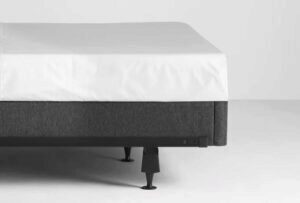How to take care of your mattress
Disclosure: By clicking on the product links in this article, Mattress Nerd may receive a commission fee at no cost to you, the reader. Read full disclosure statement.
Alright, so you bought a new mattress, and now you need to make it last. If you buy a good mattress and take care of it, it can last you a decade or longer. If you don’t take care of it, you might cut the lifetime in half. Here is a list of things to do to keep the mattress feeling new as long as possible.
Rotate Your Mattress
Most mattresses these days cannot be flipped (they’re built from the bottom up rather than the center out), but you can still rotate them head-to-toe. This will allow the surface to wear more evenly instead of just forming a you-shaped impression in your normal spot.
When the mattress is brand new, it’ll break in a little more quickly to it’s “normal” feel, so you might want to rotate the mattress pretty often at first. About once a month for the first 2 or 3 months.
After that, rotate your mattress around 3 or 4 times a year to keep it wearing evenly.
When the mattress gets exceptionally old and ready to be replaced, rotating the mattress is unlikely to do much. So you can probably stop at that point. Rotating the mattress should be preventive maintenance, not something you desperately try to do to fix an uncomfortable mattress.
Keep the Mattress Covered with a Protector
The advanced foams in today’s mattresses need to be kept dry. Oils, perspiration, other bodily fluids, food or drink, and just regular humidity can all infiltrate the foams of your mattress and break them down, leading to premature sagging. This is aside from the other reasons to get a mattress protector.
Having a nice mattress without a protector is like buying a new smartphone without a case. It’s a silly risk to take with such a large investment. Even a cheap mattress protector will do the job, but the more expensive ones will feel better under the sheets.
Keep the Mattress Supported Properly
I recommend not putting a new mattress on a very old box spring. In addition to likely voiding the mattress warranty, the boxspring might not be as structurally sound as it once was, and if it’s a very old boxspring, it might be the wrong kind (mattresses these days generally need rigid foundations. Older boxsprings had actual springs).
There are several ways to support your mattress. A platform bed with enough cross slats offers great support. A new boxspring and a frame is great, as long as the frame has a center support bar with at least one leg going from that bar to the ground. Your warranty may be void unless you have that bar. Mattresses are heavier these days than they used to be, so a 20-year-old bed frame might not hold up under the weight of a modern mattress.
Be Careful when Moving the Mattress
Some mattresses are meant to be bent. For example, some foam mattresses like Leesa come compressed in a box. Those can be bent as far as needed for you to move it. Other mattresses can be flexed a little bit. Many with individually pocketed coils fall into this category.
Other mattresses, especially a lot of the cheaper coil mattresses, are not designed to be bent. If you’re picking up such a mattress from a store, don’t try to cram it into your SUV if it’s not going to fit without bending. This can damage the coils (especially the “helical wire,” which is the wire that ties the coils together.)
Also, if you move and take your mattress with you, make sure it’s covered up well. Get some mattress bags for the mattress and boxspring. Like I said before, you don’t want the mattress to get wet or dirty.
Lastly, Use Common Sense
This one should be fairly self-explanatory. For example, don’t jump on the bed, don’t put an old mattress under the new one instead of a box spring (yes, this was a real thing one of my customers tried), don’t smoke in bed… use common sense. Treat the mattress like the expensive, important item that it is.
Thanks for reading!


